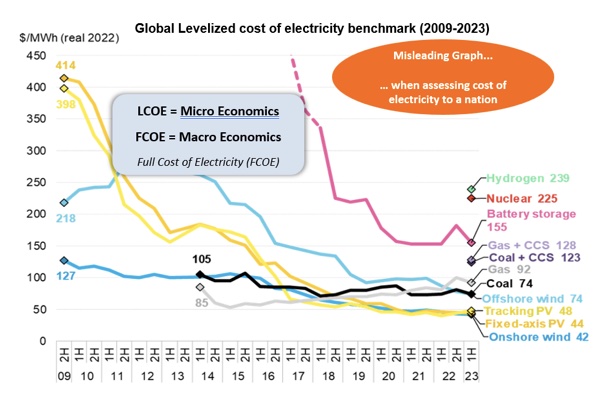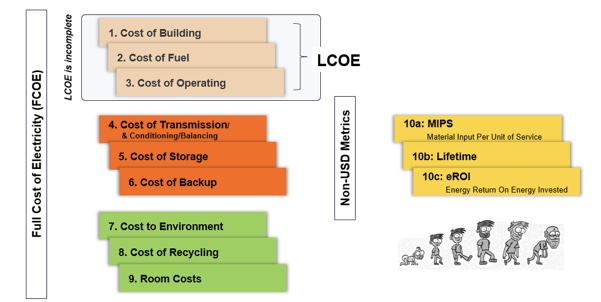October 30, 2024 Global Warming
It would make sense to redirect investment from wind, solar and hydrogen to areas where the funding would have a real positive impact on both the environment and the economy, if we are to hope for a truly sustainable long-term future for life, health and prosperity, especially for the poorer classes.
The cost of electricity. If too high, it hinders industrial development
Over the past 150 years, the abundance of electricity from coal and gas has led to unprecedented reductions in poverty and increases in life expectancy.
Today, these reliable and, above all, cheap sources of energy generate around 60 per cent of the world’s electricity and 50 per cent of its primary energy.
But right now, due to the crazy politics about non-existent climate change, coal – and gas – based fuels are (thankfully still slowly) being replaced by so-called “renewable energy sources”, such as wind and solar power.
Bloomberg has published its latest analysis of the global levelized cost of electricity (LCOE) in 2023, comparing the historical LCOE of the various “renewables” with the cost of coal, gas and nuclear power, and coming to the misleading conclusion that wind and solar are the cheapest sources of electricity.

Reports and analyses based on LCOEs, also carried out by other organisations such as the IEA, IRENA, IEEFA, IMF, have been taken into account by virtually all governments belonging to the UN, and have concluded (wrongly) that the transition from a coal – and gas – based energy system to a wind- or solar – based system will save billions, if not trillions, on a global scale.
Of course all politicians know the three pillars of a successful energy policy :
Reliability
Cost-effectiveness
Environmental sustainability
The first concern should be how to produce electricity reliably, and only then should affordability, if any, be considered.
Only when a balance between reliability and affordability has been achieved can we move on to analysing environmental sustainability.It is important to note at this point that the claim that ‘renewable’ energy produced by wind and solar is cheap and free of environmental impact is a fundamental misunderstanding and, above all, damaging to the global energy economy.
The truth, currently unpopular with the mass media but recognised by leading economic institutions such as the OECD and the IEA, is as follows :
Wind and solar have always been more expensive than coal and gas, even nuclear
Total costs are rising exponentially
The result is that the proposed “energy transition” would cost (at least) 7 to 10 per cent of global GDP, amounting to trillions of dollars, and, based also on IPCC data, far beyond the “GW cost”.
But why is it wrong to use LCOE (Levelized Cost Of Electricity) to assess a country’s energy costs?
The LCOE is a ‘micro-economic’ rather than a whole system view that excludes seven types of costs (listed below) and will therefore never be an accurate indicator on which governments can base energy policy decisions.
The LCOE is misleading because it does not consider or account for intermittency, low natural capacity, the correlation between wind and solar ‘availability’ across continents, and the diversity of supply and demand at a local level.
Here are the obvious costs that are not included in the LCOE :
Backup or Long Duration Energy Storage (LDES) : wind and solar require at least 100% backup or storage for every MW installed
Grid integration, including transmission, distribution and balancing costs
Some of the less obvious costs that are not included in the grid scale LCOE include :
Efficiency losses : more wind and solar means lower resource utilisation of backup or grid systems
Space costs : space requirements are driven by the low energy density (per m²) of wind and solar. There is an economic and environmental cost to “using” thousands of km² to capture the diffuse energy of the sun and wind.Recycling costs, due to the low energy density (per kg) and short lifetime of wind and solar energy
Environmental costs : damage to flora and fauna, adverse effects on climate systems, including heating, wind use and atmospheric changes
Raw material and net energy inefficiency (eROI) – of the whole system of production, processing, transport, refining, manufacturing and reuse, including environmental impacts.
Only an accurate estimate of the Full Cost of Electricity (FCOE) includes all costs and should be used to estimate the total cost of electricity production for a state.

What will be the consequences for humanity if grid-scale wind and solar technologies increase energy costs and reduce energy security ?
Even the globalists’ megaphone magazine, The Economist (a symbol of their coveted Great Reset), was forced to admit that in the UK alone, excessively high electricity prices in the winter of 2022/23 caused more than 65,000 more deaths than the average of recent years.
High energy costs not only cause more suffering for the weaker and disadvantaged classes in the most industrialised countries, but also hold back industrial development in developing countries.
Strictly speaking, however, if wind and solar are inferior grid-scale energy solutions, then so is hydrogen produced by wind and solar.
Remember that H2 “loses” 65-80% of the energy input for production, storage, transport and repowering.
Hydrogen is dangerous to store and especially to transport, being highly explosive and so “thin” that it can pass through and damage even steel.
If released into the environment, its “global warming impact” would be 12 times that of CO2.
In conclusion, there is no doubt that it is necessary to try to develop alternative forms of energy that are environmentally friendly.
However, an eventual “transition” to alternative energy sources such as wind, solar and hydrogen will involve both a significant increase in the cost of energy and a sharp reduction in its reliability, as well as serious impacts on ecosystems.
These are all highly counter-productive factors with unacceptable consequences for the whole of humanity.
Poverty, peace, health, education and the environment would deserve the utmost attention from governments, but they are short of funds precisely because of the massive investments in “renewable” energies.
It would make sense to redirect investment away from wind, solar and hydrogen to areas where funding would have a real positive impact on both the environment and the economy, precisely so that we can hope for a truly sustainable long-term future for life, health and prosperity, especially for the poorer classes.













